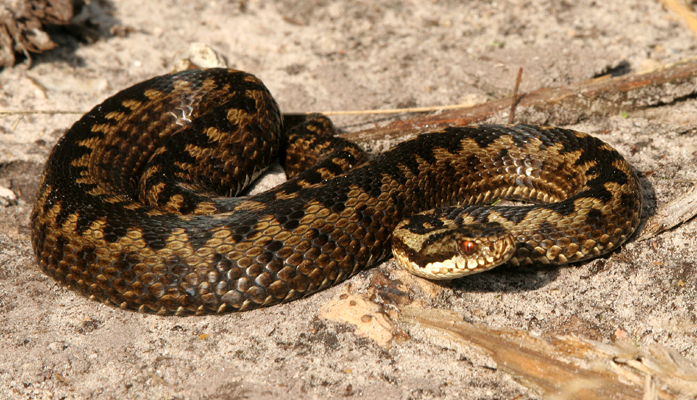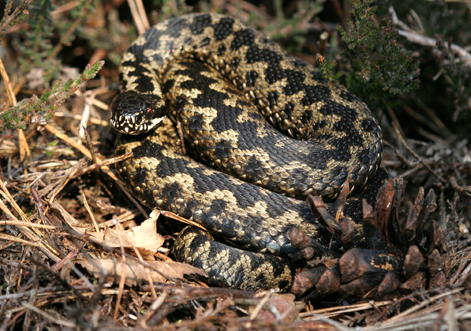Adder Spotting

The reward for hours spent searching for Adders can be sight of beautiful animals such as this snake.
(Ash woods, Surrey 2005).

This Adder has found a last shaft of sunlight for basking as evening sets. This demonstrates how Adders are drawn to direct sunlight.
(Ash woods, Surrey 2006).
The best way to spot Adders is to determine a place where they are known to exist. This may be a local heath, common or even a nature reserve. Most areas of public-access countryside will have an appointed warden or conservation officer. Check your local council webpages to find who this is, and ask them where the best places are to spot Adders. Another useful source of information is the local Amphibian and Reptile Group (ARG). Be prepared for people to be secretive about Adder sites, as human persecution is, sadly, still a threat to Adders.
Observing reptiles in the wild can be difficult, and lack of sightings after hours of effort is usual for beginners, and can sap the initial enthusiasm. Knowing Adders are present in an area will help morale, and you can use a known site to hone your skills.
Once you have found a site, you must next decide whereabouts on the site is the best place to look. Adders require good dense ground cover, where they can hide from predators, yet also require sunny spots for basking. Adders tend to prefer higher (drier) ground in Spring and Autumn, and will readily adopt dips on a hillside as protection from the wind. South facing slopes are preferred, as sunlight will fall on these areas for more of the day.
Adders are very shy animals and will disappear into cover silently as soon as they detect your approach. Walk slowly and lightly as ground vibrations can be picked up by Adders at a considerable distance. Pause occasionally to scan the edges of undergrowth. Walk with the sun behind your back, so you are looking at the undergrowth along your shadow. This way you will be looking into sheltered basking spots, rather than over undergrowth which obscures sunny positions. Look at the edges of good ground cover (ideally a mixture of deep moss and heather), in direct sunlight.
Although Adders are active in conditions as cold as 6°C probably the best temperature range for spotting Adders is between 9°C and 28°C (48-82°F). Better days will have intermittent cloud cover, as continual sunshine allows the Adder to warm more quickly, and to bask less frequently, and the best chance of spotting Adders is when they are basking. Choosing a morning after rainfall the previous night provides even better chances for spotting Adders, as the dampness in the ground will cool the snake, such that it has to bask to gain the required energy for the day's activity.
Looking at cover close to your feet means that you would have to get very close to an Adder without it spotting you first. Its best to scan the ground-cover at a distance of at least 12 feet (4m) although further is better, scanning ahead and closer alternately, as Adders have excellent camouflage. If possible, walk such that any wind is blowing from the direction you are walking towards, as Adders have an excellent sense of smell, and could otherwise detect your presence.
If you are lucky enough to spot an Adder, remain motionless, and if possible crouch, very slowly, to the ground. Adders are very sensitive to objects moving against the sky, as most of their predators are birds. If the Adder moved into deep cover, and providing it was not unduly disturbed, mark the location with a twig, it is likely to reappear within 20 minutes to the same spot to continue basking.